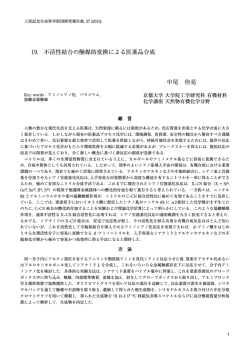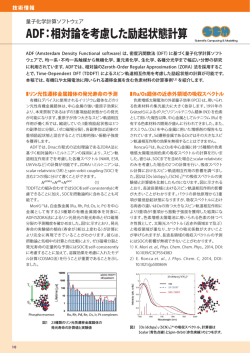
4P094 ミスマッチ塩基対挿入下における [Ru(bpy)2dppz]2+ の 発光増強
Published on Web 11/20/2002 4P094 Turning the [Ru(bpy)2dppz]2+ Light-Switch On and Off with Temperature 2+ Matthew K. Brennaman, James H. Alstrum-Acevedo, Cavan N. Fleming, Paul Jang, ミスマッチ塩基対挿入下における [Ru(bpy) 2dppz] の ,† Thomas J. Meyer,* and John M. Papanikolas* 発光増強に関する理論研究 Contribution from the Venable and Kenan Laboratories, Department of Chemistry, UniVersity of North Carolina at Chapel Hill, Chapel Hill, North Carolina 27599 (お茶の水女子大学人間文化創成科学研究科)◯大塚 美穂、鷹野 景子 Received July 29, 2002 Abstract: We report temperature-dependent excited-state lifetime measurements on [Ru(bpy)2dppz]2+ in both protic and aprotic solvents. These experiments yield a unifying picture of the excited-state photophysics 2 that accounts for observations in both types of solvent. Our measurements support the notion of bpy-like and phz-like states associated with the dppz ligand and show that the ligand orbital associated with the bright state is similar in size to the corresponding orbital in the 3MLCT state of [Ru(bpy)3]2+. In contrast to the current thinking, the experiments presented here indicate that the light-switch effect is not driven by a (Ochanomizu Univ., ofalways Humanities and state reversal. Rather, theyGraduate suggest that theSchool dark state is lowest in energy, even Sciences) in aprotic solvents, and that the light-switch behavior is the result of a competition between energetic factors that favor the ◯Miho Keiko TAKANO dark state and entropic factors OTSUKA, that favor the bright (bpy) state. Theoretical study on luminescent enhancement of [Ru(bpy) dppz]2+ binding to mismatched base pairs I. Introduction 【背景】生体分子と相互作用する金属錯体は化学診 2+ There has been intense interest in [Ru(bpy)2dppz] (Figure 1) as a luminescent probe of DNA. In particular, this complex 断・治療などへの応用が期待される。本研究の対象 is brightly luminescent when bound to DNA, but is nonemissive 1-3 The “light-switch” 2+ は、 in aqueous solution. effect stems from である [Ru(bpy) 水溶媒中では発光し 2(dppz)] hydrogen bond formation with water, which quenches the excited-state luminescence and reduces the quantum yield by ないが DNA 存在下で発光を示すという特徴をもち、 2-3 orders of magnitude. In the bound form, the dppz ligand intercalated into the DNA strand. Intercalation shields the DNAis の分子プローブとしての活用が注目されてき phenazine nitrogens from the solvent and results in a luminescent excited state. The stark contrast between the dark and bright 配位 た [1]。この錯体の光スイッチの機構は、dppz states of this molecule makes this complex useful for the study 2+ Figure 1. Chemical of the light-switch complex, 図 1structure [Ru(bpy) dppz] [Ru(bpy) と 2dppz]2+, 2 4-11 DNA microenvironments. and ligand fragments discussed in the text. 子 がof関 連 and し other た nonpolar 2 種の metal-to-ligand charge dppz 配位子の化学構造 [2] The light-switch property does not require DNA for activa- environments. transfer (MLCT): 配位子内 bpyofへの tion, and luminescence dppz is observed in a number aproticMLCT Consequently, this complex has been studied in a wide variety of solvents in an attempt to understand the origin * To whom correspondence shouldphz be への addressed. E-mail: (明状態), dppz 配位子内 MLCT(暗状態)の存在から説明されており、 of the light-switch mechanism.12-14 The photophysical factors [email protected]. † Present address: Los Alamos National Laboratory MS A127, Los that govern this function are thought to arise from the presence この Alamos, 2 状態の相対関係を支配する要因として、 phz 上窒素原子と溶媒水分子間の水素 NM 87545. of two metal-to-ligand charge-transfer (MLCT) states on the (1) Friedman, A. E.; Chambron, J. C.; Sauvage, J. P.; Turro, N. J.; Barton, J. dppz ligand: a bright, luminescent state associated with the dark, 31, 10809-10816. nonluminescent state localized largely on the phenazine (phz) (3) Turro, C.; Bossmann, S. H.; Jenkins, Y.; Barton, J. K.; Turro, N. J. J. Am. マッチ塩基対挿入下における発光強度が適正塩基対挿入の場合よりも大きいことが Chem. Soc. 1995, 117, 9026-9032. portion. It has been suggested that in aprotic environments, the (4) Holmlin, R. E.; Stemp, E. D. A.; Barton, J. K. Inorg. Chem. 1998, 37, bright state is the lower energy state, and thus luminescence is 29-34. 報告された (5) Sabatani, [4]。ミスマッチ塩基対と適正塩基対への挿入では、異なる挿入様式(ミ E.; Nikol, H. D.; Gray, H. B.; Anson, F. C. J. Am. Chem. Soc. observed. The light-switch is activated in protic solvents by 1996, 118, 1158-1163. hydrogen bond formation at the phz nitrogens, which lowers (6) Chang, Q.; Murtaza, Z.; Lakowicz, J. R.; Rao, G. Anal. Chim. Acta 1997, スマッチ塩基対: insertion, 適正塩基対:intercalation 350, 97-104. the energy )および異なる挿入部位(ミ of the dark state below the bright state. Because of K. J. Am. Chem. Soc. 1990, 112, 4960-4962. 結合相互作用が提唱されている(図1)[2,3]。この錯体について、2009 年に、ミス (2) Jenkins, Y.; Friedman, A. E.; Turro, N. J.; Barton, J. K. Biochemistry 1992, bipyridine (bpy) fragment of the dppz ligand and a (7) Guo, X. Q.; Castellano, F. N.; Li, L.; Lakowicz, J. R. Biophys. Chem. 1998, 71, 51-62. スマッチ塩基対:側溝,適正塩基対:主溝)をもち、錯体まわりの環境が異なると考 (8) Ling, L. S.; He, Z. K.; Song, G. W.; Han, H. Y.; Zhang, H. S.; Zeng, Y. (12) Nair, R. B.; Cullum, B. M.; Murphy, C. J. Inorg. Chem. 1997, 36, 962E. Mikrochim. Acta 2000, 134, 57-62. 965. (9) Ling, L. S.; He, Z. K.; Song, G. W.; Zeng, Y. E.; Wang, C.; Bai, C. L.; (13) Olson, E. J. C.; Hu, D.; Hormann, A.; Jonkman, A. M.; Arkin, M. R.; えられる Chen,[4,5]。本研究では、ミスマッチ塩基対挿入下における発光増強の要因を明 X. D.; Shen, P. Anal. Chim. Acta 2001, 436, 207-214. Stemp, E. D. A.; Barton, J. K.; Barbara, P. F. J. Am. Chem. Soc. 1997, (10) Ling, L. S.; Song, G. W.; He, Z. K.; Liu, H. Z.; Zeng, Y. Microchem. J. 119, 11458-11467. 1999, 63, 356-364. (14) Coates, C. G.; Callaghan, P. L.; Mcgarvey, J. J.; Kelly, J. M.; Kruger, P. らかにすることを目的とし、錯体と水溶媒の相互作用に着目して考察した。 (11) Chambron, J. C.; Sauvage, J. P. Chem. Phys. Lett. 1991, 182, 603-607. E.; Higgins, M. E. J. Raman Spectrosc. 2000, 31, 283-288. 15094 9 J. AM. CHEM. SOC. 2002, 124, 15094-15098 10.1021/ja0279139 CCC: $22.00 © 2002 American Chemical Society 【計算方法】構造上の特性と溶媒水分布を解析するため、分子動力学(MD)計算を 行った。結晶構造(PDB: 4E1U, 5’-(dCGGAAATTACCG)2-3’, 下線:ミスマッチ塩基 対箇所)[5] を基にミスマッチ塩基対挿入錯体と適正塩基対挿入錯体のモデルをそれ ぞれ構築し、これら2つのモデルと孤立錯体 [Ru(bpy)2dppz]2+ を対象とした。力場 には ff99bsc0(オリゴヌクレオチド、水)および generalized AMBER force field (GAFF) [6](Ru 錯体)、錯体の電荷には restricted electrostatic potential (RESP) 電 荷を用いた。Ru 原子のファンデルワールスパラメータとして、R = 2.170, ε = 0.48 [6] を用いた。錯体と水 2 分子を顕においたモデルについて、TD-DFT (B3LYP/SDD(Ru), 6-31G*(N, C, H)) 計算を行い、水溶媒分布の違いが吸収遷移特性に与える影響を考察 した。水の溶媒効果は PCM で取り込み、計算は Gaussian09 で行った。 【結果と考察】動径分布関数(RDF)を解析し、phz 上窒素原子まわりの溶媒水分子 の水素原子の分布を調査した。孤立錯体とオリゴヌクレオチド挿入錯体の間には明ら かな違いがみられ、オリゴヌクレオチド挿入下では錯体が水溶媒の接近から守られて いるという提唱 [2] とよく対応した。一方、ミスマッチ塩基対挿入下と適正塩基対挿 入下について、RDF の立ち上がり位置は、適正塩基対挿入下(3.0 Å)の方がミスマ ッチ塩基対挿入下(3.6 Å)よりも近いことが分かった。これは、適正塩基対挿入下 においては水分子が接近し易いために発光強度が小さくなるという実験的推測 [4,5] と矛盾しない。図 2 に、各モデルにおける錯体まわりの構造を示した。錯体の挿入角 はミスマッチ塩基対挿入(88°)と適正塩基対挿入(64°)で大きく異なる。また、錯 体の挿入の深さについて、ミスマッチ塩基対挿入の方が Ru-P 距離が短く、オリゴヌ クレオチド鎖に対してより深くまで挿入していることが分かった。これらの構造上の 違いは、錯体まわりの溶媒水分子分布に影響すると考えられる。構造についての詳細 および TD-DFT 計算結果については当日発表する。 ミスマッチ塩基対挿入下錯体 適正塩基対挿入下錯体 Ru P Ru P P 挿入角 (deg): 88 Ru-P 距離 (Å): 7.9, 8.4 P 挿入角 (deg): 64 Ru-P 距離 (Å): 10.4, 14.6 図2 ミスマッチ塩基対挿入下錯体と適正塩基対挿入下錯体の構造。Ru 錯体は球、錯体 まわりの塩基対および糖鎖をワイヤーモデルで示した。挿入角は P-P 軸(点線)と dppz 軸(実線)の角度で、挿入の深さは Ru-P 距離で見積もった。 【参考文献】[1] Friedman, A. E. et al., J. Am. Chem. Soc., 1990, 112, 4960. [2] Brennaman, M. K. et al., J. Am. Chem. Soc., 2002, 124, 15094. [3] Olson, E. J. C. et al., J. Am. Chem. Soc., 1997, 119, 11458. [4] Lim, M. H. et al., Inorg. Chem., 2009, 48, 5392. [5] Song, H. et al., Nat. Chem., 2012, 4, 615. [6] Very, T. private communication.
© Copyright 2025

